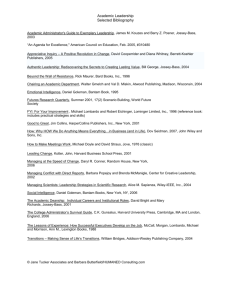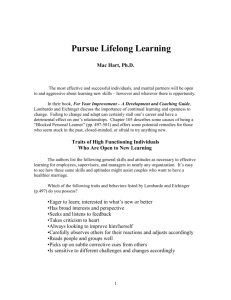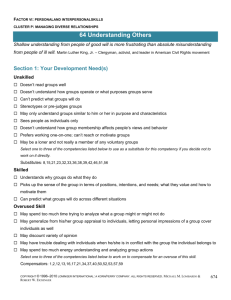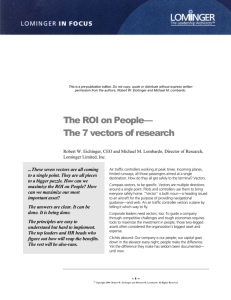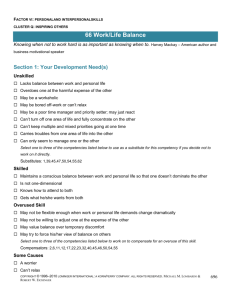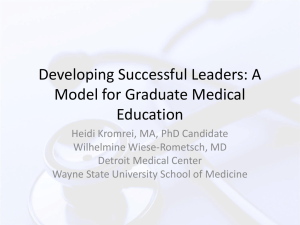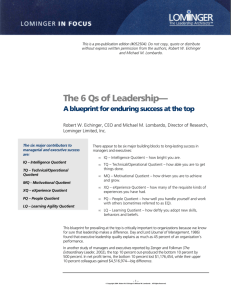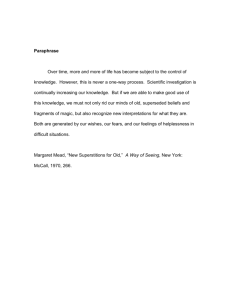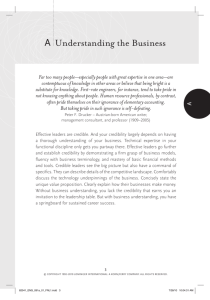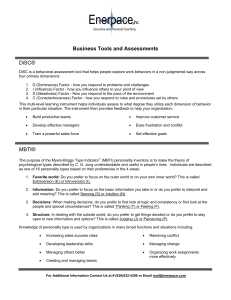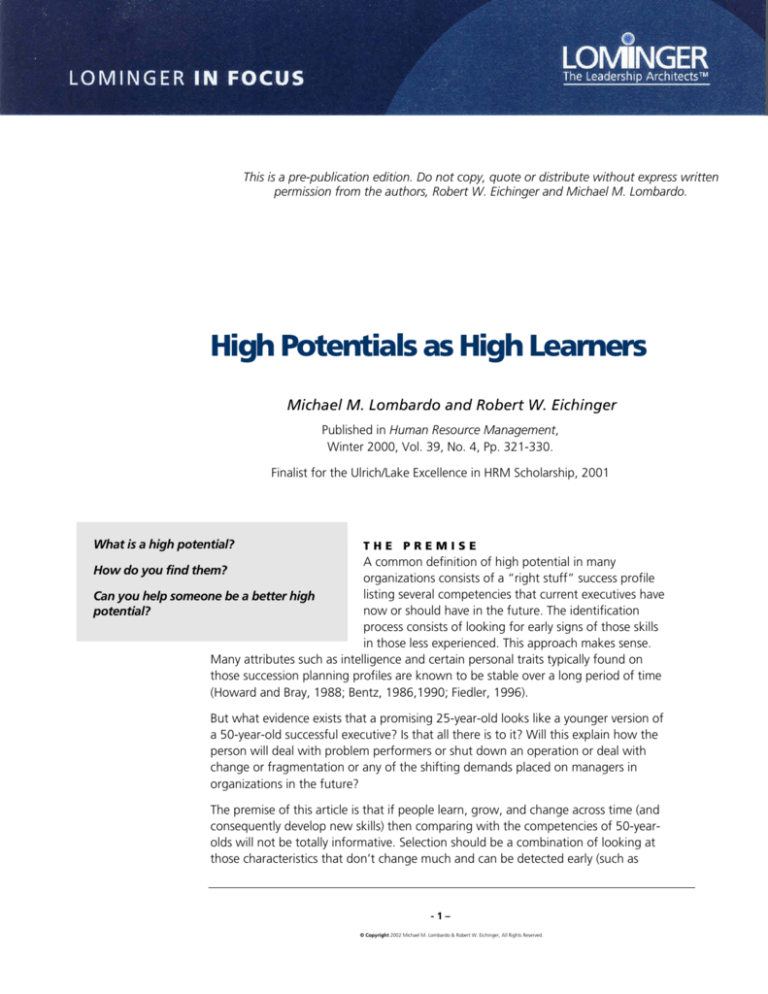
Lominger Limited, Inc.
This is a pre-publication edition. Do not copy, quote or distribute without express written
permission from the authors, Robert W. Eichinger and Michael M. Lombardo.
High Potentials as High Learners
Michael M. Lombardo and Robert W. Eichinger
Published in Human Resource Management,
Winter 2000, Vol. 39, No. 4, Pp. 321-330.
Finalist for the Ulrich/Lake Excellence in HRM Scholarship, 2001
What is a high potential?
THE PREMISE
A common definition of high potential in many
organizations consists of a “right stuff” success profile
listing several competencies that current executives have
Can you help someone be a better high
now or should have in the future. The identification
potential?
process consists of looking for early signs of those skills
in those less experienced. This approach makes sense.
Many attributes such as intelligence and certain personal traits typically found on
those succession planning profiles are known to be stable over a long period of time
(Howard and Bray, 1988; Bentz, 1986,1990; Fiedler, 1996).
How do you find them?
But what evidence exists that a promising 25-year-old looks like a younger version of
a 50-year-old successful executive? Is that all there is to it? Will this explain how the
person will deal with problem performers or shut down an operation or deal with
change or fragmentation or any of the shifting demands placed on managers in
organizations in the future?
The premise of this article is that if people learn, grow, and change across time (and
consequently develop new skills) then comparing with the competencies of 50-yearolds will not be totally informative. Selection should be a combination of looking at
those characteristics that don’t change much and can be detected early (such as
-1–
© Copyright 2002 Michael M. Lombardo & Robert W. Eichinger, All Rights Reserved.
Lominger Limited, Inc.
intelligence) and those that flower across time as the person learns to deal with fresh
situations.
In our view, learning from experience is how a person demonstrates what is termed
high potential. Few would argue that potential can be detected from current
performance in an area the person already knows well. The word potential according
to Webster’s means, “existing in possibility; capable of developing into actuality.”
So it cannot be fully detected from what a person can already demonstrate—it
requires that the person do something new or different. In our definition, potential
involves learning new skills (or honing current ones) in order to perform in first-time
situations.
To support this argument, we will deal with two issues. First, there needs to be some
evidence that people do learn, grow, and change across their careers. Otherwise, we
should just use the variables that can be detected quite early. Second, there needs to
be evidence that measuring learning from experience, acumen, or agility can be
accomplished reliably and that it relates to something of importance in organizations,
namely one’s designation as a high potential.
THE CASE FOR
LEARNING,
GROWTH, AND
CHANGE
While certain skills and attributes can be selected for, it seems what happens after
hiring a person has as much or more impact on long-term worth as anything which
has gone before. In the long-term AT&T studies (Howard and Bray, 1988; Bray,
Campbell, and Grant, 1974) for example, those who were assessed low for potential
were often more successful if they had developmental jobs and developmental
bosses. A greater percentage of low assessed were promoted than were high
assessed if their developmental opportunities were noticeably better.
Two of the studies at the Center for Creative Leadership (McCall, Lombardo and
Morrison, 1988; Morrison, White and Van Velsor, 1992) found that if people have
certain powerful on-the-job experiences and learn from them, that this bodes well for
long-term job success. Sternberg, Wagner, Williams and Horvath (1995) identify
street smarts (or learning from experience) as far more correlated with level attained
in organizations than IQ. In a similar vein, emotional intelligence (McClelland, 1999;
Goleman, 1998) has been related to performance.
Thus the evidence is compelling for the building of managers across time. In addition
to the studies cited above, the work of Hall (1986, 1995), Gabarro (1987), and Hill
(1992) paint a portrait of the learning process necessary to make transitions from an
individual contributor to the first level of supervision to the executive suite. McCauley,
Eastman, and Ohlott (1994) have demonstrated how different job demands create
different learning demands—how there is some pattern to what managers see and
gain from their experiences.
More recently, Hollenbeck and McCall (1999) summarize the state of current
developmental practices, and Conger and Benjamin (1999) detail the efforts of
innovative organizations to improve their success rate in building leaders.
-2–
© Copyright 2002 Michael M. Lombardo & Robert W. Eichinger, All Rights Reserved.
Lominger Limited, Inc.
PEOPLE DIFFER AS LEARNERS FROM EXPERIENCE
It further appears that people benefit differentially from experiences: Some learn new
perspectives and behaviors from life and work and some don’t. In one of the Center
for Creative Leadership studies (McCall et al., 1988), successful executives had a
strong and similar pattern of learning from key job assignments. The derailed
executives, all of whom had been successful for many years and had gone through
many of the same key assignments as the successful executives, had virtually no
pattern of learning from jobs.
DERAILMENT IS PARTLY NOT LEARNING NEW
THINGS
In a companion study (McCall and Lombardo, 1983), one of the key reasons cited for
derailment was being blocked to new learning. According to organizational insiders
interviewed, people quit learning, thought they were infallible, became legends in
their own minds, or couldn’t make the transition to a different job or way of
behaving. They relied on what had gotten them to where they were, ironically
becoming victimized by their past successes. They got locked into standard ways of
thinking and acting that didn’t really meet the new demands. They also
underestimated the newness of the demands, seeing them as just another version of
what they had done before.
Once dug into this non-learning pattern, strengths tipped over into overuses and
weaknesses as they did more of what had previously been a good thing. The bright
sometimes lorded it over others and missed getting new ideas, the organized became
detail drones and missed the big picture, the creative had their fingers in too many
pies and couldn’t innovate, the aggressive over-managed and couldn’t empower or
build a team.
FAILURES ARE USUALLY NOT LEARNING NEW
THINGS
Failures to learn new things almost inevitably result in failures to perform over the
long term. Changing circumstances call for rapid learning and fresh skills. Many
studies (e.g., Sternberg et al., 1995) note learning quickness or street smarts as a key
in performing in difficult transitions or new jobs. For example, the Benchmarks®
instrument (McCauley, Lombardo and Usher, 1989) which is based on the learnings
from experience reported by hundreds of successful executives, contains scales which
correlated strongly with performance, potential, and actual promotion.
Another recent study (Spreitzer, McCall & Mahoney, 1997) related performance as an
expatriate to learning. Expatriate jobs contain a high portion of performing under
first-time and tough changing conditions. A major finding was that curiosity, learning
adventuresomeness, and more effective learning from experience differentiated high
potentials from average performers.
-3–
© Copyright 2002 Michael M. Lombardo & Robert W. Eichinger, All Rights Reserved.
Lominger Limited, Inc.
WHY WERE THE SUCCESSFUL EXECUTIVES
SUCCESSFUL?
In contrast to those with similar experiences who derailed, successful executives were
different or were helped to become different in several ways:
SO WHAT DOES
THIS ALL MEAN?
•
They sought and got more feedback (from self or others) on how they came
across to others and what they needed to do to improve and perform better.
•
They had roughly twice the variety (but sometimes the same number) in the
“on the job” leadership challenges they faced.
•
They responded to this newness and adversity by learning new skills and
additional ways of thinking (Lombardo and Eichinger, 1989).
These independent streams of research provide evidence that effective managers and
professionals learn and change across time and that this new learning matters for
performance. The skills acquired so far is certainly an issue in selection of high
potentials; more so is what they can acquire in the future—their skill in learning to do
what they don’t yet know how to do. The measurement of potential can be
strengthened by adding another concept to success profiles, that is, the willingness
and ability to learn new competencies in order to perform under first-time, tough or
different conditions.
WHAT CHARACTERIZES THE LEARNING AGILE?
This leads to the second question of what these learning agile people do and think
and how they might be identified. Other than saying that all organizations would like
to have people who eagerly learn new skills in response to tough, changing
circumstances, how would such people be identified?
We conducted two studiesi to see whether we could better define what a superior
learner from experience (someone who is learning agile) looked like with the goal of
creating an instrument managers could use to assist in nominating high potentials
with greater ease and accuracy.
The questionnaire was somewhat based on a series of studies conducted at CCL.
Through content analysis of interview and survey data of executives (Lindsey, Homes
and McCall, 1987), as well as a research intervention study with 55 managers, it
became apparent that those who succeeded in making a behavioral or attitudinal
change had specific learning strategies that they could articulate to varying degrees.
Further review of relevant literature on learning strategies—such as studies of
children who “spontaneously” learn to read (Pressley, Borkowski and Schneider,
1987; see Appendix: Selected Learning References for other listings)—indicated there
were some common themes in learning something new.
Items were written to tap constructs of learning agility that were hypothesized from
prior studies and relevant literature. All items were either explicitly learning oriented
or required learning in order to perform under first-time conditions.
-4–
© Copyright 2002 Michael M. Lombardo & Robert W. Eichinger, All Rights Reserved.
Lominger Limited, Inc.
Someone who knew the person well, usually a boss or long-time associate, filled out
over 400 questionnaires across the two studies. Ratees were also independently rated
by a second person: usually a boss, Human Resource professional or succession
planning officer with access to organization judgments/ratings of the person. Two
ratings were completed: a performance/potential continuum and a propensity to get
in trouble with others.
The first measure runs from (1) poor, to (2) OK performance, to (3) excellent
performance but not promotable (usually due to lack of skills for higher jobs), to (4)
promotable although not yet a high performer at this time (may be new in job as
high potentials often are), to (5) high performer and high potential. We put
performance and potential together purposefully so we could examine pure potential
regardless of performance and also potential with performance.
The second measure, propensity to get in trouble, was included because some
experience with active learners suggests that at their worst they can change things
that don’t need changing, alienate others, etc. We wanted to insure we were not
measuring overly aggressive though not always successful change agents. While this
might be somewhat indicative of learning acumen, it wouldn’t often lead to effective
change.
RESULTS
As a result of factor analysis, four factors that describe different aspects of learning
agility were constructed.
1. People Agility—Describes people who know themselves well, learn from experience,
treat others constructively, and are cool and resilient under the pressures of change.
2. Results Agility—Describes people who get results under tough conditions, inspire
others to perform beyond normal, and exhibit the sort of presence that builds
confidence in others.
3. Mental Agility—Describes people who think through problems from a fresh point of
view and are comfortable with complexity, ambiguity, and explaining their thinking to
others.
4. Change Agility—Describes people who are curious, have a passion for ideas, like to
experiment with test cases, and engage in skill building activities.
Each of these factors was significantly associated with being considered a high
potential and staying out of trouble. The four factors together correlated significantly
with both criterion measures (R-square = .30 for both). Each scale correlates
significantly with both criterion measures (P<.0001).
We also looked at the correlational patterns for five cuts of the data. A measure of
learning skill should show similar and significant results across age, gender, levels of
management and individual contributor positions, both line and staff positions, and
hold across companies.
Learning acumen should not necessarily increase with age or level, for example, but
rather reflect characteristics and skills of the person that help the person learn in new
-5–
© Copyright 2002 Michael M. Lombardo & Robert W. Eichinger, All Rights Reserved.
Lominger Limited, Inc.
situations consistently over time. If 45-year-olds had significantly better results than
30-year-olds, we might have to conclude that something else, such as the jobs they
had held and the courses they had attended, influenced these skills along the way.
The results bore out our hopes. The correlational patterns were similar and significant
for all five groupings. These findings suggest that learning skill or agility is important
in the identification of potential for both genders, for varying age groups, for both
line and staff roles, across levels of management and for individual contributor
positions, and in all six companies in the studies.
SUMMARY OF THE CHARACTERISTICS OF THE
LEARNING AGILE
From the data, we can say that people high in learning agility and therefore possibly
high potentials are described as:
•
Seeking and having more experiences to learn from.
•
Enjoying complex first-time problems and challenges associated with new
experiences.
•
Getting more out of these experiences because they have an interest in
making sense of them.
•
Performing better because they incorporate new skills into their repertoire.
The face they show to the outside world is described as follows:
•
Being eager to learn about self, others, and ideas.
•
Showing genuine willingness to learn from feedback and experience and
change their behavior and viewpoints as a result.
•
Being interested in helping people think and experiment.
•
Being resilient and philosophical about what happens to people who push
change.
•
Being uncompromising—while wide open to diversity, multiple sources and a
range of views, once they incorporate these into their thinking, they are
described as stalwart in pushing their notions. They rely on logic,
perseverance, well-thought-through ideas, and cool communications to sell
their points.
Going a bit beyond the data, we present two hunches about the learning agile.
SOME HUNCHES
1. Learning as the Goal. People high in learning agility seem to be driven to learn
as a value in itself. They are interested in people, ideas, and so forth in order to
learn. For example, they may not build a team because this is a “good” thing to
do. If they build a team, it is because they think a team is absolutely necessary to
carry out an experiment or push a change through. In other circumstances, they
might be indifferent or even scoff at the value of teams. If they help others solve
problems, it is probably as much for the mental discipline of learning about
problem solving as it is in helping others. If they believe in diversity, it’s because
-6–
© Copyright 2002 Michael M. Lombardo & Robert W. Eichinger, All Rights Reserved.
Lominger Limited, Inc.
they know they can learn more from difference than sameness. Their
characteristic behaviors, we hypothesize, are largely instrumental to their
continued growth.
2. Staying Out of Trouble With Balance. Tinkerers can get into a lot of trouble in
organizations, which necessarily run largely off systems designed to ensure
sameness and handle exceptions. Since high learners can be like fingernails on a
blackboard at times, our second hunch is that they stay out of trouble through
self-knowledgeii. They know who they are and are especially likely to know their
limits and learn from their mistakes—they apparently don’t suffer from an excess
of hubris. This may help them get away with being different—pushing change,
enduring the heat, and being somewhat uncompromising, but balancing this with
no glaring weaknesses and showing their concern for others through helpfulness
and listening.
We are currently aware of six uses of the questionnaire within organizations:
IMPLICATIONS
FOR HUMAN
RESOURCES
To Improve the Pool of High Potentials
1. To help nominate high potentials. Some companies use the profile from the
questionnaire along with performance track record and the usual subjective
judgment of potential. All tracks need to be seen as positive for a person to
qualify as a high potential. Some use it as a training tool to educate managers
about the difference between performance and potential to help them nominate
better candidates.
2. As an expansive talent search process, hunting out people who have the capacity
to learn new skills and deal with change but who may presently only be lightly
challenged or not in visible roles. In this application, large numbers of people are
assessed to see if there are any high scorers among people not well known to top
management. This broad screening technique might catch more females and
ethnic minorities than the typical succession planning process. It also allows an
earlier start to assignment management and experience building.
3. To cross-check existing high potential lists. As one source of data, along with
performance and other considerations, some companies have looked at one’s
scores on the questionnaire to add or subtract people from the high potential list.
It is also being used for situations where there is a difference of opinion. In that
case, both advocates rate the person on the instrument to see if they can account
for the difference.
To Develop the Best
4. As a tie breaker in selection for challenging assignments. Given several qualified
candidates, the questionnaire has been used to inform the question of who could
do the job and learn most from the assignment.
5. For development. A common use has been to write development plans against a
person’s pattern of learning agility scores—to help a person become more open
to other points of view, for example. The goal is to increase a person’s chances of
learning from experience and therefore help him/her increase potential.
6. For risky assignments. In line with the expatriate findings from Spreitzer et
al.(1997) cited above, the tool is used to make sure that the person assigned to a
-7–
© Copyright 2002 Michael M. Lombardo & Robert W. Eichinger, All Rights Reserved.
Lominger Limited, Inc.
tough, new and risky assignment can rapidly learn from experience and be
successful.
CONCLUSION
To deal with change, organizations need to find and nurture those who are most
facile in dealing with it. Identifying those who can learn to do something differently
requires a different measurement strategy from those often employed, one that looks
at the characteristics of the learning agile. In this article, we have explained some
initial steps toward identifying the women and men with the most potential to lead,
regardless of what the future may hold for them.
-8–
© Copyright 2002 Michael M. Lombardo & Robert W. Eichinger, All Rights Reserved.
Lominger Limited, Inc.
NOTES
i Due to space limitations, the steps followed in the research will not be presented here. Interested readers should contact Michael Lombardo mlombardo@mindspring.com for a technical summary.
ii In an intervention conducted while one of the authors was at the Center for Creative Leadership, the highest learners had no overdone strengths or notable flaws reported. They were characterized
by being highly self-critical, eager to improve, and self-aware enough not to run into problems with others.
E X E C U T I V E A S S E S S M E N T
R E F E R E N C E S
A N D
D E V E L O P M E N T
Bentz, J.V. (April, 1986). Research findings from personality assessment of executives.
Paper presented at the Human Resource Planning Society Conference, Scottsdale,
Arizona.
Bentz, J.V. (1990). Contextual issues in predicting high level leadership performance:
contextual richness as a criterion consideration in personality research with
executives. In K.E. Clark & M.B. Clark (Eds.), Measures of leadership (pp. 131143). West Orange, N.J.: Leadership Library of America.
Bray, D., Campbell, R. & Grant D. (1974). Formative years in business: A long term
AT&T study of managerial lives. New York: Wiley.
Conger, J., & Benjamin, B. (1999). Building Leaders. San Francisco: Jossey-Bass.
Fiedler, F. (1996) Research on Leadership Selection and Training: One View of the
Future. Administrative Science Quarterly, Vol. 41, 243.
Gabarro, J.J. (1987). The dynamics of taking charge. Boston: Harvard Business School
Press.
Goleman, D. (1998). Working with Emotional Intelligence. New York: Bantam Books.
Hall, D.T. (1986). Dilemmas in linking succession planning to individual executive
learning. Human Resource Management, 25, 215-234.
Hall, D. T. (1995). Executive careers and learning: Aligning selection, strategy, and
development. Human Resources Planning, 18:2, 14-23.
Hill, L.A. (1992). Becoming a manager. Boston: Harvard Business School Press.
Hollenbeck, G.P. and McCall, M.W. (1999). Leadership Development: Contemporary
Practice. In A. I. Kraut and A. K. Korman (eds.), Evolving Practices for Human
Resources Management: Responses to a Changing World of Work. San Francisco:
Jossey-Bass.
Howard, A. & Bray, D. (1988). Managerial lives in transition: Advancing age and
changing times. New York: Guilford Press.
Lindsey, E.H., Homes, V., & McCall, M.W. (1987). Key events in executives’ lives.
Greensboro, N.C.: Center for Creative Leadership.
-9–
© Copyright 2002 Michael M. Lombardo & Robert W. Eichinger, All Rights Reserved.
Lominger Limited, Inc.
Lombardo, M. & McCauley, C.D. (1993). Benchmarks®: A Manual and Training
Guide. Greensboro, N.C.: Center for Creative Leadership.
Lombardo, M. & Eichinger, R. (1989). Preventing derailment: What to do before it’s
too late. Greensboro, N.C.: Center for Creative Leadership.
McCall, M., Lombardo, M. and Morrison, A. (1988). The lessons of experience.
Lexington, Mass.: Lexington Books.
McCall, M. & Lombardo, M. (1983). What makes a top executive? Psychology Today,
17(2), 26-31.
McCauley, C.D., Lombardo, M. & Usher, C. (1989). Diagnosing management
development needs: An instrument based on how managers develop. Journal of
Management 15(3), 389-403.
McCauley, C.D., Ruderman, M.N., Ohlott, P.J., & Morrow, J.E. (1994). Assessing the
developmental components of managerial jobs. Journal of Applied Psychology,
79, 544-560.
McClelland, D. (1999). Identifying competencies with behavior-event interviews.
Psychological Science, 9(5), 331-339.
Morrison, A., White, R. & Van Velsor, E. (1992). Breaking the glass ceiling: Can
women reach the top of America’s largest corporations? Reading, MA: Addison
Wesley.
Spreitzer, G.M., McCall, M.W. & Mahoney, J.D. (1997). Early identification of
international executive potential. Journal of Applied Psychology, 82:1, 6-29,
Sternberg, R. J., Wagner, R. K., Williams, W. M., and Horvath, J. A. (1995). Testing
common sense. American Psychologist, 50:11, 912-927.
S E L E C T E D
L E A R N I N G
R E F E R E N C E S
Akin, G. (1987). Varieties of managerial learning. Organizational Dynamics, 16(2), 3648.
Argyris, C. (1994). Good communication that blocks learning. Harvard Business
Review, July-August, 77-86.
Bunker, K.A. & Webb, A.D. (1992). Learning how to learn from experience: Impact of
stress and coping (Report no. 154). Greensboro, NC: Center for Creative
Leadership.
Daudelin, M. W. (1996). Learning from experience through reflection. Organizational
Dynamics, 24:3, 36-48.
Davies, J., & Easterby-Smith, M. (1984). Learning and developing from managerial
work experiences. Journal of Management Studies, 21, 169-183.
Dechant, K. (1994). Making the most of job assignments: An exercise in planning for
learning. Journal of Management Education, 18:2, 198-211.
- 10 –
© Copyright 2002 Michael M. Lombardo & Robert W. Eichinger, All Rights Reserved.
Lominger Limited, Inc.
DiVesta, F.J. (1989). Applications of cognitive psychology to education. In Wittrock,
M. & Farley, F. (Eds.), The future of educational psychology (pp.37-73). Hillsdale:
Erlbaum.
Eichinger, R. & Lombardo, M. (1990). Twenty-two ways to develop leadership in staff
managers (Report no. 144). Greensboro, NC: Center for Creative Leadership.
Kaplan, R.E., with Drath, W.H. & Kofodimos, J.R. (1991). Beyond Ambition. San
Francisco, California: Jossey-Bass.
Kouzes, J. & Posner, B. (1987). The leadership challenge. San Francisco: Jossey-Bass.
Kotter, J. P. (1988). The leadership factor. New York: Free Press.
Kotter, J. P. (1995). The new rules: How to succeed in today’s post-corporate world.
New York: Free Press.
Louis, M.L. (1980). Surprise and sense making: What newcomers experience in
entering unfamiliar organizational settings. Administrative Science Quarterly, 25,
226-251.
McCall, M.W. (1998). High Flyers: Developing the Next Generation of Leaders.
Boston: Harvard Business School Press.
McCauley, C.D., Eastman, L.J., & Ohlott, P.J. (1995). Linking management selection
and development through stretch assignments. Human Resource Management,
34(1). 93-115.
McDonald, S. (1995). Learning to Change. Organization Science. 6(5), 557-568.
Pressley, M., Borkowski, J.G., & Schneider, W. (1987). Cognitive strategies: Good
strategy users coordinate metacognition and knowledge. Annals of Child
Development, 4, 89-129.
Siebert, K. W. (1999). Reflection in Action: Tools for Cultivating On-the-Job Learning
Conditions. Organizational Dynamics, 27:4.
Van Velsor, E., & Hughes, M.W. (1990). Gender differences in the development of
managers: How women managers learn from experience (Report no. 145).
Greensboro, NC: Center for Creative Leadership.
Wick, C.W., & Leon, L.S. (1993). The learning edge: How smart managers and smart
companies stay ahead. New York: McGraw-Hill.
Lominger Limited, Inc. 5320 Cedar Lake Road South Minneapolis, MN 55416-1643 www.lomingercom
Phone: 952-345-3610 Fax: 952-345-3601 business_office@lominger.com
- 11 –
© Copyright 2002 Michael M. Lombardo & Robert W. Eichinger, All Rights Reserved.

